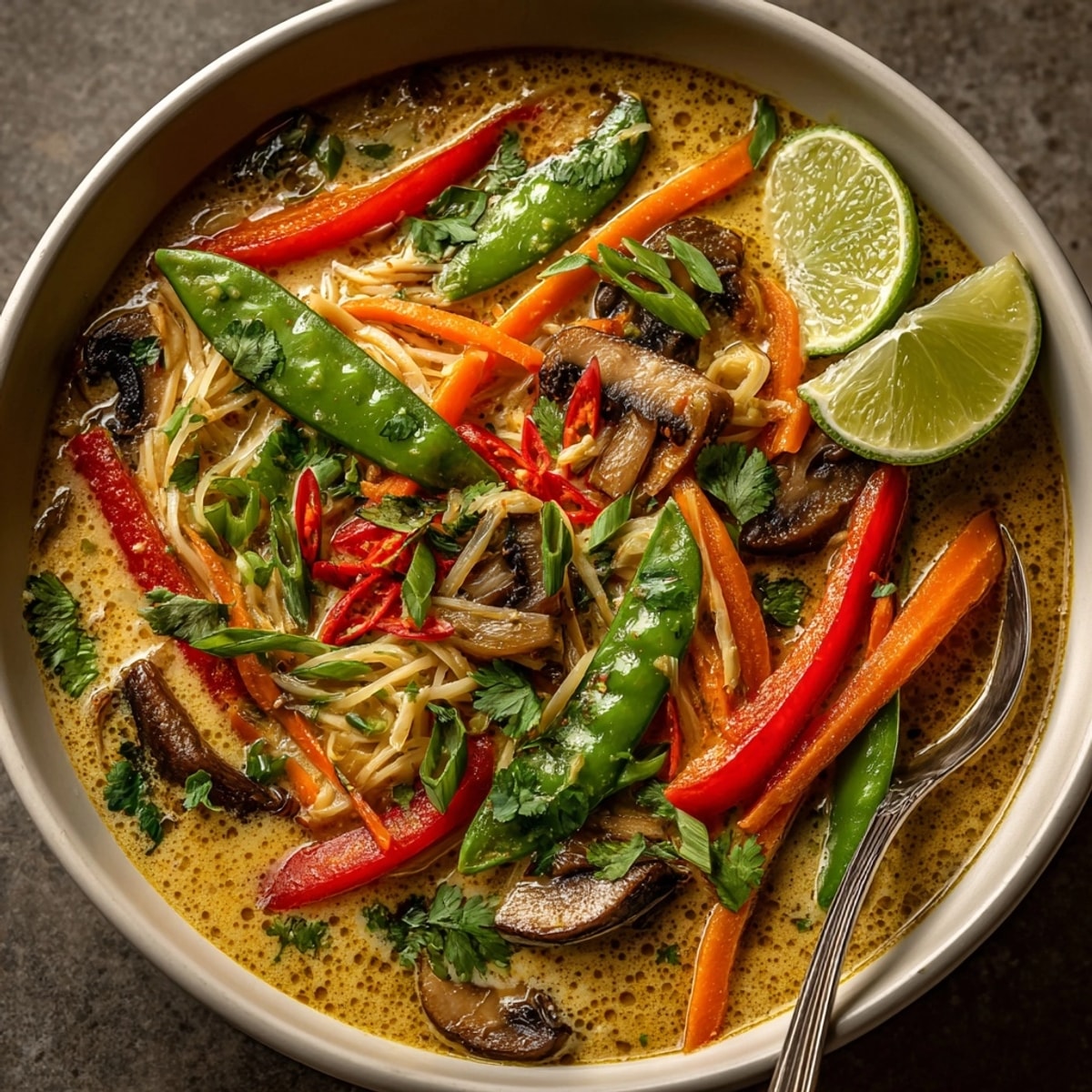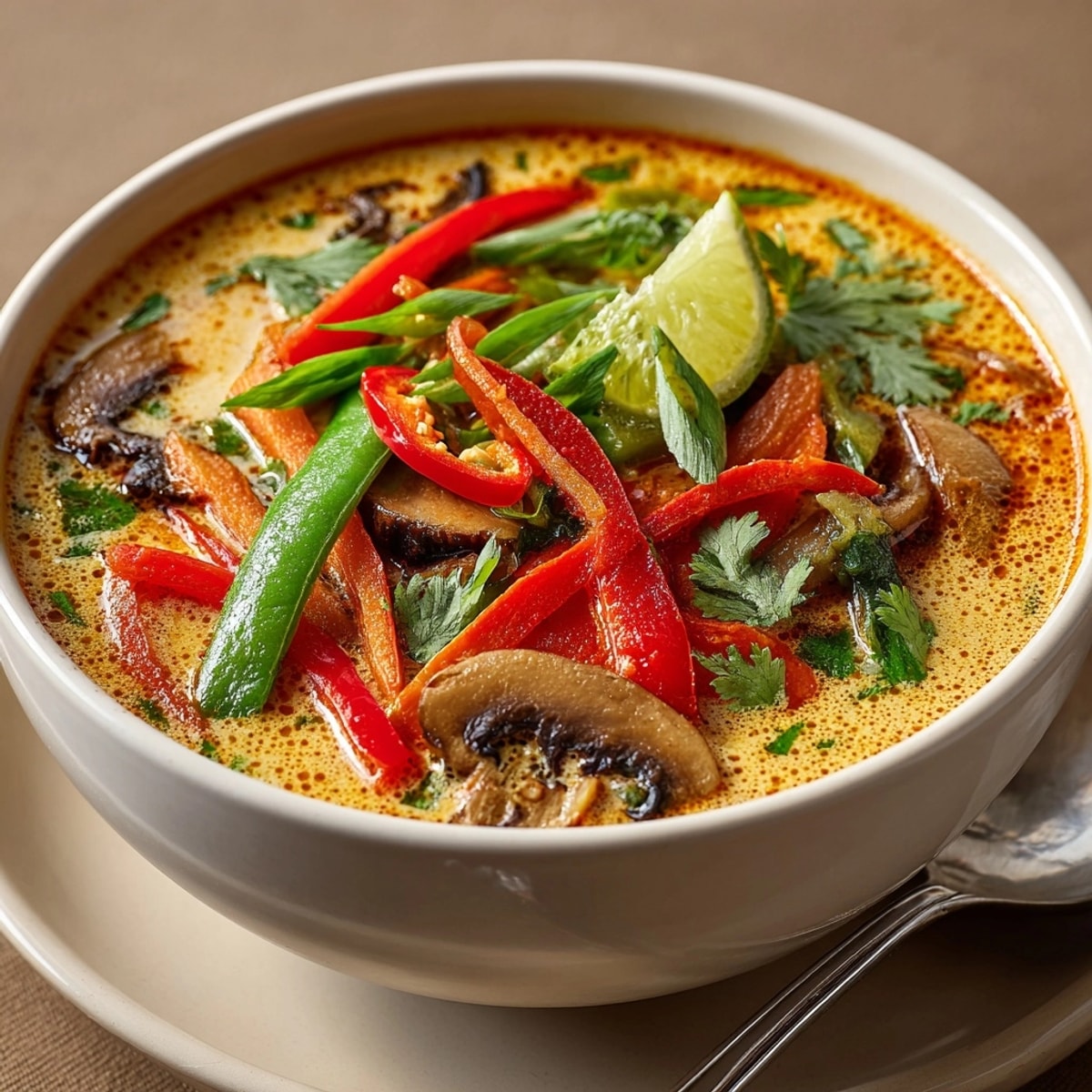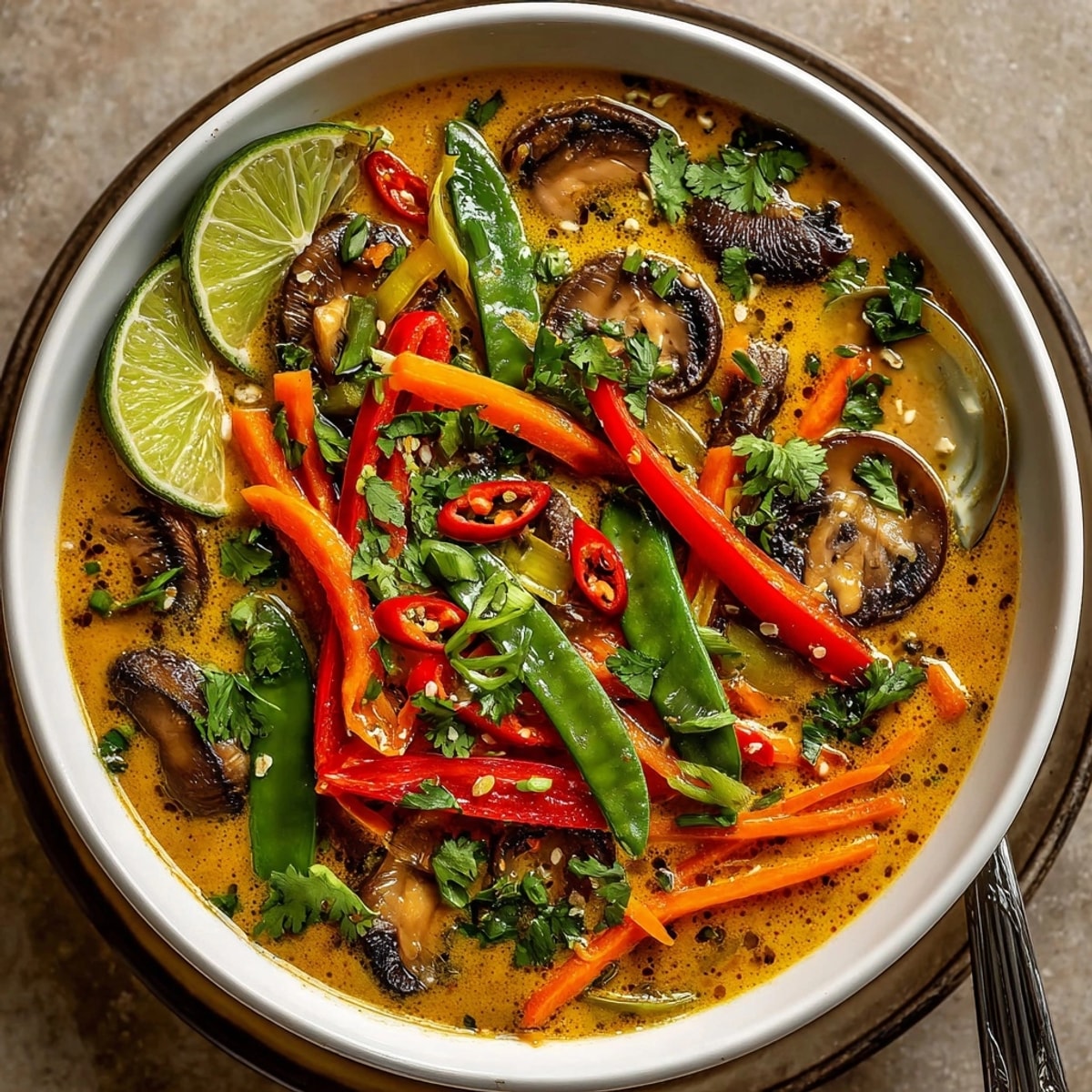 Save
Save This Thai Ginger Coconut Curry Soup has been my cold-weather sanctuary for years, offering the perfect balance of creamy coconut, warming ginger, and aromatic curry in every spoonful. The vibrant colors and fragrant steam rising from the bowl never fail to lift spirits, even on the gloomiest days.
I first discovered this recipe during a particularly harsh winter when I was craving something that would warm me from the inside out. After experimenting with different Thai flavor combinations, this soup became my signature dish that friends now specifically request when visiting.
Ingredients
- Vegetable oil: Creates the perfect base for sautéing without overpowering the delicate flavors look for a neutral variety without strong taste
- Fresh ginger: Provides that distinctive warming quality essential to Thai cooking use young ginger for less fibrous texture and brighter flavor
- Thai red curry paste: Delivers authentic flavor in one simple ingredient choose brands without shrimp paste if serving vegetarians
- Coconut milk: Creates the luxurious creamy texture full fat version yields the richest results but light works in a pinch
- Fresh lime juice: Adds the essential brightness that balances the rich coconut always add at the end to preserve the vibrant flavor
- Soy sauce: Provides the umami depth that makes the soup satisfying choose low sodium varieties to better control salt levels
Instructions
- Build the Aromatic Base:
- Heat your vegetable oil in a large pot over medium heat until it shimmers slightly but doesn't smoke. Add your finely chopped onion, spreading it evenly across the pot's surface to ensure consistent cooking. Sauté for a full 2 to 3 minutes, stirring occasionally until the onions become translucent and just begin to soften. This creates the foundation of flavor for your entire soup.
- Activate the Aromatics:
- Add your minced garlic and freshly grated ginger to the translucent onions. Stir continuously for exactly one minute to prevent burning while allowing the heat to release their essential oils. You'll know they're ready when the kitchen fills with their intoxicating aroma. This step is crucial for developing the soup's characteristic Thai fragrance.
- Bloom the Curry Paste:
- Add the Thai red curry paste directly to your aromatic mixture and stir constantly for one minute. This process, called blooming, allows the oil to extract and enhance the paste's complex flavors and spices. The paste will become more fragrant and slightly darker as the spices toast in the oil. This technique dramatically intensifies the curry flavor throughout the finished soup.
- Soften the Vegetables:
- Add your prepared bell pepper, carrots, mushrooms, and snap peas to the pot. Sauté them for 3 to 4 minutes while stirring occasionally to coat them evenly with the curry mixture. The vegetables should soften slightly but maintain their vibrant color and some firmness. This partial cooking ensures they'll reach perfect tenderness in the final soup without becoming mushy.
- Create the Broth Base:
- Pour the vegetable broth into the pot and bring everything to a gentle simmer. You'll see small bubbles forming around the edges of the pot but not the rolling boil of rapidly bubbling liquid. This gentle heat preserves the delicate flavors while beginning to unite all the elements into a cohesive broth.
- Develop the Signature Creaminess:
- Stir in the coconut milk, soy sauce, and brown sugar until completely incorporated. Allow the soup to simmer uncovered for 10 to 12 minutes, stirring occasionally. During this time, the liquid will reduce slightly, the vegetables will become perfectly tender, and the flavors will meld together. The soup will develop its signature silky texture and rich golden color with hints of orange from the curry paste.
- Brighten with Citrus:
- Remove the pot from heat completely before stirring in the fresh lime juice. This prevents the lime from becoming bitter while preserving its bright, fresh quality. Taste the soup and add more lime juice, soy sauce, or a pinch of salt if needed. The flavor should be a perfect balance of creamy, savory, slightly sweet, and tangy.
- Garnish and Serve:
- Ladle the hot soup into individual bowls, making sure each serving gets a good balance of vegetables and broth. Top generously with fresh cilantro leaves, sliced green onions, a wedge of lime on the side, and thin slices of red chili if you enjoy extra heat. These fresh garnishes add crucial brightness, color contrast, and textural elements to the finished dish.
 Save
Save The ginger is truly the heart of this recipe. I discovered its importance when I once tried to make the soup without it during a pantry emergency. The difference was remarkable. My grandmother always said ginger was natures medicine, and whenever I make this soup, I think of how she would approve of this warming, healing bowl of comfort.
Make It a Complete Meal
This soup transitions beautifully from appetizer to main course with a few simple additions. For a protein boost, add cubed firm tofu during the last 5 minutes of cooking, or shredded rotisserie chicken if youre not vegetarian. Serve the soup over a small portion of jasmine rice or thin rice noodles placed in the bottom of each bowl before ladling the soup over. The starch soaks up the flavorful broth while making the meal more substantial. For a complete Thai inspired dinner, pair with fresh summer rolls with peanut dipping sauce as an appetizer.
Ingredient Substitutions
The beauty of this recipe lies in its flexibility. If red curry paste is unavailable, use yellow or green curry paste for a different but equally delicious flavor profile. Cannot find fresh ginger? Use 1 teaspoon ground ginger in a pinch, though the flavor will be less vibrant. Light coconut milk can replace full fat for a lower calorie option, though the soup will be less creamy. For a soy free version, coconut aminos make an excellent substitute for soy sauce. Vegetable wise, this soup welcomes what you have on hand. Baby bok choy, broccoli florets, zucchini, or sweet potato cubes all work beautifully depending on the season.
Seasonal Adaptations
Spring version features asparagus, snow peas, and fresh herbs
Summer adaptation incorporates zucchini, corn, and cherry tomatoes
Fall variation includes butternut squash, kale, and extra warming spices
The Art of Thai Soup Balance
The magic of Thai cuisine lies in its perfect balance of five fundamental flavors. This soup exemplifies this harmony with coconut milk providing richness, lime juice adding sourness, brown sugar contributing sweetness, curry paste delivering spiciness, and soy sauce offering saltiness. Understanding this balance allows you to adjust to your preference. If your soup tastes flat, it likely needs more acid from lime. Too spicy? Add a touch more coconut milk or sugar to temper the heat. This intuitive approach to seasoning is what elevates home cooking to restaurant quality results.
Storage and Reheating
Store leftover soup in an airtight container in the refrigerator for up to 3 days. The flavors actually develop and improve overnight, making this an excellent make ahead meal. When reheating, do so gently over medium low heat, stirring occasionally until just heated through. Avoid boiling which can cause the coconut milk to separate and the vegetables to become overly soft. For best results, hold back some fresh garnishes to add after reheating to restore the bright, fresh element. This soup also freezes surprisingly well for up to 2 months, though the vegetables may soften slightly upon thawing.
 Save
Save This soup is a flavorful and warming dish perfect for any season. Enjoy the aromatic blend of ginger and curry, and feel free to adjust the spice level to your liking.